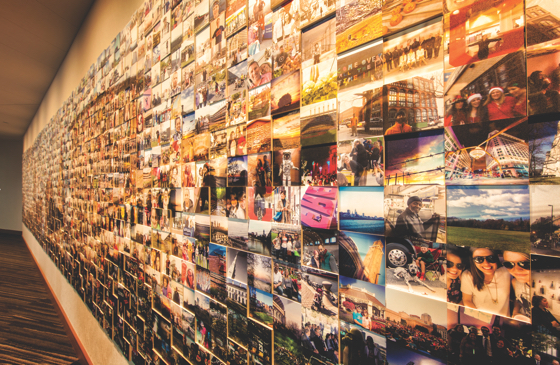The Hilton Cleveland Hotel, before its opening last year, promoted an Instagram campaign that got the community involved in designing a community-driven work of art composed entirely of Instagram snaps. Here’s how they did it:
The hotel
Hilton Cleveland Downtown, a 600-room hotel connected to the city’s Huntington Convention Center. It opened in mid-2016 amid a Republican convention and a national basketball championship in the city.
The project
A multimedia campaign, from May 2015 to January 2016, to collect 2,800 Instagram photos at city venues and events to be part of a 560-by-80-inch art piece composed to represent the city’s skyline. The piece was intended to hang in a busy hallway connecting the hotel to the convention center.
The goal
Inspire a community-driven project to galvanize civic pride and showcase the city’s unique identity to thousands of business and leisure visitors annually.

The challenge
Create, manage and complete a multifaceted promotional campaign and project for a hotel that wouldn’t open for months, in time for its June 1, 2016, debut.
The cost
Besides work hours by Carolyn Deming, director of public relations, the hotel’s marketing coordinator and its PR team, the project received US$24,000 from the county, which owns the hotel property and initiated the project, to pay for the software and to fabricate the piece. Art curation firm Kalisher chose the
photos and tweaked the skyline image.
The backstory
“Prior to this epic year that Cleveland had, it was sort of an unknown (city),” Deming says. “So people had no impression or the wrong impression. 2016 shattered that in a most wonderful way.”
Pieces by 54 artists, 46 of them from Cuyahoga County, are scattered around the hotel. “From the very beginning, integrating local art was a huge priority,” she says.
The process
A press release touting the campaign was published in May 2015. Over ensuing months, the hotel and its PR teams kept the campaign top of mind through social media, publicity and shoe leather: “Street teams,” armed with cameras and iPads, went to tourist locations to tell people about the contest.
The key was repetition, and responses came in waves. Influential local bloggers were offered an in-kind partnership – a free night at the hotel in exchange for a mention (with a disclaimer that no money was exchanged). Four blogs garnered 1,390 views and about 500 entries in the two days after they were posted, and a few ensuing posts goosed submissions as well. Posts were published regularly on the hotel’s website and social media platforms, with the #myclephoto hashtag. Another wave of publicity ensued when local media picked up on the campaign.
Serendipity occasionally intervened: Deming attended a Cavaliers basketball game and posted a picture of herself wearing the mascot’s hat. The team retweeted it, “and that brought a whole new audience with the hashtag,” she says.
Besides scouting locations like the Rock and Roll Hall of Fame, the hotel scouted events like public festivals. Pounding the pavement worked. “You’d see a surge after Beerfest and Winterfest,” Deming says.
The result
The hotel hit its deadline, and “people love it,” says Deming, who adds that many had trouble envisioning the result until they saw it. Perhaps the most astounded was the couple who appeared in the mural’s central photo, snapped on their wedding day in the city’s theater district. The photo, which won a contest, had been submitted on a lark.
What they would do differently
Launch the social media campaign before the general press release. “You want to have the conversation with people in the space in which you’re collecting (the photos),” Deming says. “Have the website and social media and hashtag aligned first.” Adds Teri Agosta, the hotel’s general manager: “We needed to simplify the whole process for people who wanted to post.”
Conclusion
The Instagram installment is known outside the hotel – visitors to the hotel bar on the 32nd floor inquire about it, and participants in the art tours offered by the hotel gasp audibly when they see it, Agosta says.
“We’re a revitalized city,” Deming says. “Cleveland is now on the map.” And visitors have 2,800 ways to remember it.
